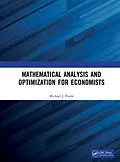In Mathematical Analysis and Optimization for Economists, the author aims to introduce students of economics to the power and versatility of traditional as well as contemporary methodologies in mathematics and optimization theory; and, illustrates how these techniques can be applied in solving microeconomic problems.
This book combines the areas of intermediate to advanced mathematics, optimization, and microeconomic decision making, and is suitable for advanced undergraduates and first-year graduate students. This text is highly readable, with all concepts fully defined, and contains numerous detailed example problems in both mathematics and microeconomic applications. Each section contains some standard, as well as more thoughtful and challenging, exercises. Solutions can be downloaded from the CRC Press website. All solutions are detailed and complete.
Features
- Contains a whole spectrum of modern applicable mathematical techniques, many of which are not found in other books of this type.
- Comprehensive and contains numerous and detailed example problems in both mathematics and economic analysis.
- Suitable for economists and economics students with only a minimal mathematical background.
- Classroom-tested over the years when the author was actively teaching at the University of Hartford.
- Serves as a beginner text in optimization for applied mathematics students.
- Accompanied by several electronic chapters on linear algebra and matrix theory, nonsmooth optimization, economic efficiency, and distance functions available for free on www.routledge.com/9780367759018.
Autorentext
Michael J. Panik is Professor Emeritus in the Department of Economics and Finance at the University of Hartford, CT. He has taught courses in economic and business statistics, introductory and advanced quantitative methods, and econometrics. Dr. Panik is the author of several textbooks, monographs, and numerous articles in professional journals.
Inhalt
Preface
Author
Symbols and Abbreviations
1. Mathematical Foundations 1
2. Mathematical Foundations 2
3. Mathematical Foundations 3
4. Mathematical Foundations 4
5. Global and Local Extrema of Real-Valued Functions
6. Global Extrema of Real-Valued Functions
7. Local Extrema of Real-Valued Functions
8. Convex and Concave Real-Valued Functions
9. Generalizations of Convexity and Concavity
10. Constrained Extrema: Equality Constraints
11. Constrained Extrema: Inequality Constraints
12. Constrained Extrema: Mixed Constraints
13. Lagrangian Saddle Points and Duality
14. Generalized Concave Optimization
15. Homogeneous, Homothetic, and Almost Homogeneous Functions
16. Envelope Theorems
17. The Fixed Point Theorems of Brouwer and Kakutani
18. Dynamic Optimization: Optimal Control Modeling
19. Comparative Statics Revisited
References
Index
